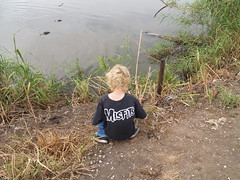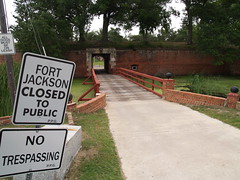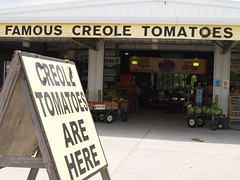View Larger Map
The answer to my question regarding the state of Plaquemines is complicated, as on the one hand, Plaquemines is doing great. The people who live there are hard working, stubborn, community orientated and have too much character to simply disappear. But on the other hand, things have obviously been tough. Mobile homes and trailers were about all you could see south of Belle Chasse. First we drove south until the road ended in Venice. We found a quaint place to have breakfast sandwiches out of a trailer called Cajun Unlimited.

The sandwiches were great, mostly because of the fresh biscuits. I asked the young man in the window named "Big Phil," who it turns out wasn't big at all, if there was anything to do in the Venice vicinity. He disappeared, apparently to ask around inside the kitchen trailer, and about a minute later he announced "There is really nothing to do here since the storm. But that pond over there has alligators." Sure enough, the pond was full of gators. Gilgamesh threw in a stick and three gators swarmed after it.

Obviously Big Phil, when not serving sandwiches, feeds the edible trash to these hungry reptiles. We then drove north to Port Sulpher to visit Fort Jackson. It's been closed since Katrina, and needs some serious restoration. Fort Jackson lies directly across the river from Fort St. Phillip, and after the War of 1812 & the Battle of New Orleans, General Andrew Jackson believed that one fort was not enough to prevent enemy forces from traveling up river to attack. There was an earlier fort about 2 miles away, called Fort Bourbon, but the soldiers there drank themselves to death. Actually I don't know what happened to Fort Bourbon. I just read it was destroyed by a hurricane in 1795. And so construction on Fort Jackson began in 1822. It's a massive pentagon-shaped brick structure, built with 20 foot thick walls to protect 500 soldiers.

Near here on March 3, 1699, Father Anastase Douay said the first mass in what was later to become Louisiana, and Pierre Le Moyne d'Iberville, the founder of Lousiiana, celebrated the first Mardi Gras in the Americas. Are we supposed to go to church on Mardi Gras? Damn! 300 years later, Rex, the King of Carnival, set up this monument to commemorate Mardi Gras' American birth in Louisiana. But in reality he set it up to shut Mobile Alabama up, as they claim to have the first American Mardi Gras in 1703.

We then drove by the Woodland Plantation, famous for being on the label of Southern Comfort bottles.We then bought some Creole tomatoes, which experts say can only be grown in the acidic soil of Plaquemines. I used to be a Nebraska tomato snob, but I've recently had some first-rate Creole tomatoes, and I think they might even be better. In any case, the secret to quality tomatoes is sandy river soil and high humidity.

Then we drove home. Our next trips this summer: Abita Louisiana, and Ship Island.
4 comments:
Thanks, my parents used to take us on those historical outings. I hated them, but I'm glad we went on them. You and editor B have given me an appreciation for Louisiana. Many of the pictures reminded me of the California delta where the Sacramento and San Joaquin rivers merge and empty into SF Bay. I wish we had alligators.
I've been jonesing to go out through St. Bernard and down the east bank.My great-great uncle owned Stella Plantation in the early 20th century, until the Perez family bought it. That's a good family drive as well, but if you've been all the way down to Venice it would probably feel a bit repetitive. You do get in the battlefield, and Rocky and Carlos.
Be sure to check out the UCM Museum in Abita. (ucmmuseum.com)It's a hoot.
Good food can be found at the Brew Pub and Mama Dee's.
Bring or rent a bike and ride it on the trace into downtown Covington or into Mandeville. Both very good rides.
Thanks for blogging about Plaquemines. The Bush Administration has decided to let Plaquemines go adrift: while the New Orleans area gets higher and improved levees, walls and gates, everybody south of Belle Chasse gets to keep what they had before Katrina. That's a guarantee of flooding and failure which is why places like Venice, Happy Jack and Irontown are so slow to recover.
Check out my blogs about Plaquemines and the hearty people who live there from when I was working down there in the months following Katrina. We seem to get the same impression about the people down there.
http://timsnamelessblog.blogspot.com/2006/04/south-of-new-orleans.html
http://timsnamelessblog.blogspot.com/2006/04/volunteers.html
Peace,
Tim
Post a Comment